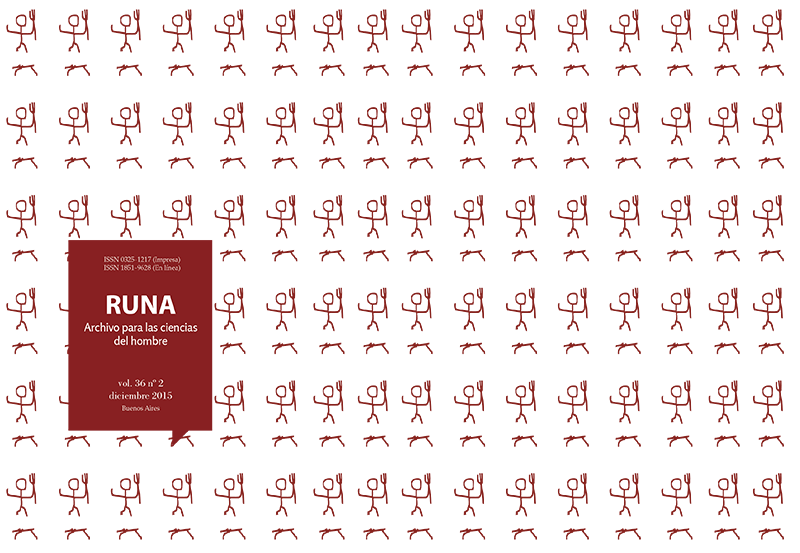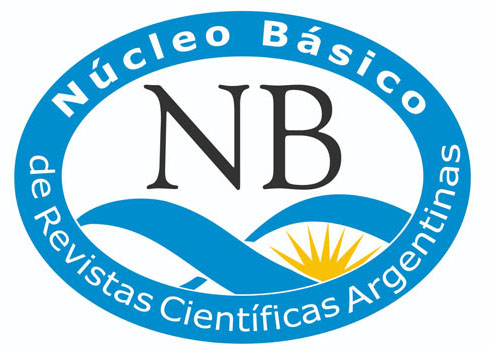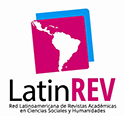Un acercamiento al estado de salud y enfermedad en las comunidades de valles y quebradas del Noroeste Argentino desde una mirada biocultural (ca. 1000- 1550 AD)
Resumen
Se evalúan los efectos que los cambios demográficos, políticos y económicos propuestos para el Noroeste Argentino ca. 1000- 1550 A.D. habrían tenido sobre el modo de vida las poblaciones que lo habitaban a partir del estudio de condiciones patológicas del cráneo y de la dentición en una muestra ósea humana procedente de la Quebrada de Humahuaca, del Valle Calchaquí y de la Quebrada del Toro (N= 268). La baja frecuencia de patologías poróticas e infecciones en la muestra completa sugiere que la mayoría de los individuos analizados no sufrieron importantes eventos de estrés nutricional-metabólico e infeccioso. Sin embargo, se registraron diferencias estadísticamente significativas en la prevalencia de patologías poróticas para ciertos sitios del Valle Calchaquí central. Estos resultados son interpretados a la luz de un enfoque biocultural que enfatiza el componente político-económico de las relaciones sociales del pasado.Descargas
Citas
ACUTO, Felix. 2007. “Fragmentación vs. Integración regional: repensando el período Tardío del Noroeste Argentino”. Estudios Atacameños, 34: 71-95.
AMBROSE, Stanley, BUIKSTRA, Jane y KRUEGER, Harold. 2003. “Status and gender differences in diet at Mound 72, Cahokia, revealed by isotopic analysis of bone”. Journal of Anthropological Archaeology, 22: 217-226.
AMBROSETTI, Juan Bautista. 1907. “Exploraciones arqueológicas en la ciudad prehistórica de “La Paya” (Valle Calchaquí- Provincia de Salta)”. Publicaciones de la Sección Antropología 3 (1-2), Facultad de Filosofía y Letras de la Universidad de Buenos Aires. Buenos Aires.
ANDRUSHKO, Valerie A. 2007. The Bioarchaeology of Inca Imperialism in the Heartland: An Analysis of Prehistoric Burials from the Cuzco Region of Peru. Unpublished Ph.D. Dissertation. University of California, Santa Barbara.
ARANDA, Claudia y DEL PAPA, Mariano. 2009. “Avances en las prácticas de conservación y manejo de restos humanos en Argentina”. Revista Argentina de Antropología Biológica, 11 (1): 89‐93.
ARANDA, Claudia, ROBLEDO, María Fernanda, ALUNNI, Daniela, AVIDO, Daniela, SALVARREDI, Alfonsina, URTIZBEREA, Patricia, ZUCCALA, Karina y VILLANUCCI, Natalia. 2009. “Primera etapa del proyecto de manejo de colecciones osteológicas en el área de antropología biológica, Museo Etnográfico, Juan B. Ambrosetti, Buenos Aires, Argentina”. IV Foro de Conservación del Patrimonio Cultural: 28‐29. Instituto de Estudios Avanzados, Caracas, Venezuela.
ARDISSONE, Romualdo. 1942. Un ejemplo de instalación humana en el Valle Calchaquí (el pueblo de Cachi). Instituto de Estudios Geográficos. Universidad Nacional de Tucumán.
AUFDERHEIDE, Arthur y RODRIGUEZ- MARTIN, Conrado. 1998. The Cambridge Encyclopedia of Human Paleopathology. Cambridge: Cambridge University Press,
BAFFI, Elvira Inés. 1992. Caracterización biológica de la población prehispánica tardía del sector septentrional del Valle Calchaquí (Provincia de Salta). Tesis de Doctorado, Facultad de Filosofía y Letras, Universidad de Buenos Aires.
BALDINI, Lidia y DE FEO, Carlos. 2000. “Hacia un modelo de ocupación del valle Calchaquí central (Salta) durante los Desarrollos Regionales”. Relaciones de la Sociedad Argentina de Antropología N. S., 25: 75-98.
BALDINI, Lidia. 2010. El espacio cotidiano: las casas prehispánicas tardías en el Valle Calchaquí, Salta. En: M. E. Albeck, C. Scattolin, y A. Korstanje (Eds.), El Hábitat Prehispánico: Arqueología de la Arquitectura y de la Construcción del Espacio Organizado. San Salvador de Jujuy: Ediunju. pp. 53–75.
BALDINI, Lidia y VILLAMAYOR, Virginia. 2007. “Espacios productivos en la cuenca del Río Molinos (Valle Calchaquí, Salta)”. Cuadernos de la UNJu, 32: 35-51.
BUIKSTRA, Jane y UBELAKER, Douglas. 1994. Standards for data collection from human skeletal remains. Arkansas Archaeological Survey research Series No. 44. Fayetteville.
CAMPILLO, Domingo. 2001. Introducción a la paleopatología. Barcelona: Bellaterra.
CASTRO, Juan, MENENDEZ, Lumila, GORDON, Florencia, FUCHS, Laura, DI BASTIANO, Andrés, DEL PAPA, Mariano, MUÑE, María y VAZQUEZ, Romina. 2009. Actualización del catálogo y de las condiciones de conservación de las colecciones de restos óseos humanos (División Antropología, Facultad de Ciencias Naturales y Museo, UNLP. En: Memorias. Publicaciones de los trabajos presentados en el I Congreso Iberoamericano y VIII Jornadas de Restauración y Conservación de Patrimonio. Soporte magnético, La Plata.
COHEN M.N. 1989. Health and the rise of civilization. New Haven: Yale University Press.
COHEN, Mark Nathan y George ARMELAGOS (Eds.). 1984. Paleopathology at the Origins of Agriculture. Orlando: Academic Press.
CONSTANZO, María de las Mercedes. 1942. Antropología Calchaquí. Revista del Instituto de Antropología, 2 (9): 213-318.
CREMONTE María Beatriz y Verónica Isabel WILLIAMS. 2007. La construcción social del paisaje durante la dominación Inca en el NOA. En: Nielsen, A.E., M.C. Rivolta, V. Seldes, M.M. Vazquez y P. Mercolli (Eds.). Procesos Sociales Prehispánicos en el Sur Andino. Córdoba: Editorial Brujas. pp. 207-236.
D’ALTROY, Terence, LORANDI, Ana María, WILLIAMS, Verónica Isabel, CALDEDARI, Milena, HASTORF, Christine, DEMARRAIS, Elizabeth y HAGSTRUM, Melissa. 2000. “Inka rule in the Northern Calchaquí Valley, Argentina”. Journal of Field Archaeology, 27 (1): 1-27.
DEBENEDETTI, Salvador. 1908. “Excursión arqueológica a las ruinas de Kipón (Valle Calchaquí-Provincia de Salta)”. Publicaciones de la Sección Antropológica 4. Universidad de Buenos Aires.
DE LORENZI, Mónica y DIAZ, Pío Pablo. 1976. La ocupación Incaica en el sector septentrional del Valle Calchaquí. Actas y Memorias del IV Congreso Nacional de Arqueología Argentina (Primera Parte), San Rafael, Mendoza. Tomo III: 75-88.
DEMARRAIS, Elizabeth. 1997. Materialization, ideology and power: the development of centralized authority among the pre-Hispanic polities of the Valle Calchaquí, Argentina. Unpublished Ph.D. Dissertation. University of California, Los Angeles.
DE WALT, Billie. 1998. The political ecology of population increase and malnutrition in southern Honduras. En: A.H. Goodman y T.L. Leatherman (Eds.), Building a new biocultural synthesis: political-economic perspectives on human biology. Michigan: University of Michigan Press. pp. 295-317.
DE WALT, Billie y PELTO, Perttie (Eds.). 1985. Micro and macro levels of analysis in anthropology. Issues in theory and research. Boulder: Westview.
DRESSLER, William. 2005. “What’s cultural about biocultural research?” Ethos, 33: 20-4
GARAY DE FUMAGALLI, Mercedes. 1998. El Pucará de Volcán, historia ocupacional y patrón de instalación. En: M.B. Cremonte (Comp.), Los desarrollos locales y sus territorios. Arqueología del N.O. Argentino y sur de Bolivia. San Salvador de Jujuy: EdiUnJu. pp. 131-154.
GATTO, Santiago. 1946. “Exploraciones arqueológicas en el Pucara de Volcán”. Revista del Museo de La Plata (N.S.). Sección Antropología IV, 18: 1-91.
GIFFORD, Chad. 2003. Local matters: Encountering the Imperial Inkas in the South Andes. Ph.D. Thesis. Columbia University, Nueva York.
GONZALEZ, Paula, BERNAL, Valeria y BARRIENTOS, Gustavo. 2005. “Estimación del dimorfismo sexual en el esqueleto pélvico y mandibular de individuos subadultos: comparación de técnicas visuales y de morfometría geométrica”. Werken, 1 (6): 49-61.
GOODMAN, Alan. 1998. The biological consequences of inequality in antiquity. En: A.H. Goodman y T.L. Leatherman (Eds.), Building a new biocultural synthesis: political-economic perspectives on human biology. Michigan: University of Michigan Press. pp. 141-169.
GOODMAN, Alan, LALLO, John, ARMELAGOS, George y ROSE, Jerome. 1984. Health changes at Dickson Mounds (A.D. 950-1300). En: M.N. Cohen y G. Armelagos (Eds.), Paleopathology at the origins of agriculture, Florida: Academic Press. pp. 271-305.
GOODMAN, Alan y LEATHERMAN, Thomas (Eds.). 1998. Building a new biocultural synthesis: political-economic perspectives on human biology. Michigan: University of Michigan Press.
GONZÁLEZ, Alberto Rex y PÉREZ, José Antonio. 1966. El área andina meridional. Actas y Memorias del 36 Congreso Internacional de Americanistas, 1: 241-265. Sevilla, España.
HAMMER, Øyvind, HARPER, David, RYAN, Paul. 2001. PAST: Paleontological Statistics Software Package for Education and Data Analysis. Palaeontologia Electronica, 4 (1): 9pp. http://palaeo-electronica.org/2001_1/past/issue1_01.htm
HRUSCHKA, Daniel Jacob, LENDE, Daniel y WORTHMAN, Carol. 2005. “Biocultural dialogues: Biology and culture in Psychological Anthropology”. Ethos, 33: pp. 1–19.
HUSS-ASHMORE Rebecca, GOODMAN, Alan y ARMELAGOS, George. 1982. “Nutritional inference from paleopathology”. Advances in archaeological method and theory, 5: 395-474.
KEELEY, Lewis. H. 1996. War Before Civilization. The myth of the peaceful savage. Oxford: Oxford University Press.
LARSEN, Clarke. 1997. Bioarchaeology: interpreting behavior from the human skeleton. Cambridge: Cambridge University Press.
LEATHERMAN, Thomas y GOODMAN, Alan. 1997. “Expanding the biocultural synthesis: Toward biology of poverty”. American Journal of Physical Anthropology, 102: 1-3.
LEMA, Verónica. 2009. Domesticación vegetal y grados de dependencia ser humano-planta en el desarrollo cultural prehispánico del noroeste argentino. Tesis de Doctorado inédita. Facultad de Ciencias Naturales, Universidad de La Plata.
MANN Robert, SYMES, Steve y BASS, William.1987. “Maxillary suture obliteration: Ageing the human skeleton based on intact or fragmentary maxilla”. Journal of Forensic Sciences, 32: 148-157.
MEINDL, Richard y LOVEJOY, Owen. 1985. “Ectocranial suture closure: A revised method for the determination of skeletal age at death based on the lateral-anterior sutures”. American Journal of Physical Anthropology , 68 (1): 57-66
MENGONI GOÑALONS. Guillermo. 2011. El aprovechamiento de la fauna en las sociedades complejas: aspectos metodológicos y su aplicación en diferentes contextos arqueológicos del NOA. En: V. Williams y M.B. Cremonte (Eds.), Al borde del Imperio. Paisajes sociales, materialidad y memoria en áreas periféricas del Noroeste Argentino. Buenos Aires: Sociedad Argentina de Antropología. pp. 312-396.
MENSFORTH, Robert, LOVEJOY, Owen, LALLO, John y ARMELAGOS, George. 1978. “The role of constitutional factors, diet, and infectious disease in the etiology of porotic hyperostosis and periosteal reactions in infants and children”. Medical Anthropology, 2:1-59.
NELSON, Ben, MARTIN, Debra, SWEDLUND, Alan, FISH, Paul y
ARMELAGOS, George. 1994. Studies in disruption: demography and health in the prehistoric American southwest. En: G. Gummerman y M. Gellman (Eds.), Understanding complexity in the prehistoric southwest”. Reading: Addison-Wesley. pp. 59-112.
NIELSEN, Axel Emil. 2001. Evolución social en Quebrada de Humahuaca (AD 700-1536). En: E. Berberián y A.E. Nielsen (Eds.), Historia Argentina Prehispánica. Córdoba: Editorial Brujas. Tomo 1. pp. 171-264
NIELSEN, Axel Emil. 2003. “La edad de los Auca Runa en la Quebrada de Humahuaca (Jujuy, Argentina)”. Memoria Americana, 11: 74-107.
NIELSEN, Axel Emil. 2006. “Plazas para los antepasados: descentralización y poder corporativo en las formaciones políticas preincaicas de los Andes Circumpuneños”. Estudios Atacameños, 31: 63-89.
NIELSEN, Axel Emil. 2007. Bajo el hechizo de los emblemas: políticas corporativas y tráfico interregional en los Andes circumpuneños. En: Nielsen, A.E., M.C. Rivolta, V. Seldes, M.M. Vazquez y P. Mercolli (eds.). Procesos Sociales Prehispánicos en el Sur Andino. Córdoba: Editorial Brujas. Vol. 1. pp. 207-236.
NUÑEZ REGUEIRO, Victor. 1974. “Conceptos instrumentales y marco teórico en relación al análisis del desarrollo cultural del noroeste Argentino”. Revista del Instituto de Antropología, Universidad Nacional de Córdoba, 5: 169-190.
POWELL, Mary. 1991. Ranked status and health in the Mississipian chiefdom at Moundville. En: M. Powell, P. Bridges y A. Mires (Eds.), What mean these bones? Tuscaloosa: University of Alabama Press. pp: 22-51.
POWELL, Mary. 1992. Is the best of health? Disease and trauma among the Mississippian elite. En: A. Baker y T. Pauketat (Ed.), Lords of the Southeast: social inequality and the native elites of southeastern North America. Washington: American Anthropological Association. pp. 81-97.
RAFFINO, Rodolfo. 1988. Poblaciones indígenas de Argentina. Buenos Aires: Editorial TEA.
REINHHARD, Karl. J. 1992. Patterns of diet, parasitism, and anemia in prehistoric west North America. En: Stuart-Macadam P. y S. Kent (Eds.), Diet, demography, and disease: changing perspectives on anemia. Nueva York: Aldine de Gruyter. pp. 219-258.
RODRIGUEZ, María Fernanda. 2011. Producción y consumo de recursos vegetales en el sitio Tolombón. En: V. Williams y M.B. Cremonte (Eds.), Al borde del Imperio. Paisajes sociales, materialidad y memoria en áreas periféricas del Noroeste Argentino. Buenos Aires: Sociedad Argentina de Antropología. pp. 195-208.
SCOTT, Eugenie Carol. 1979. “Dental wear scoring technique”. American Journal of Physical Anthropology, 51: 213-218.
SMITH, Holly. 1984. “Patterns of molar wear in hunter-gatherers and agriculturalists”. American Journal of Physical Anthropology, 63: 39-56.
SOBOLIK, Kristin. 1994. Paleonutrition: the diet and health of prehistoric Americans. Carbondale: Center for Archaeological Investigations Southern Illinois University at Carbondale.
STECKEL, Richard, ROSE Jerome, LARSEN Clarke y WALKER Phillip. 2002. “Skeletal health in the western hemisphere from 4000 B.C. to the present”. Evolutionary Anthropology, 11:142-155.
STUART-MACADAM, Patricia y KENT, Susan. 1992. (Eds.) Diet, demography, and disease: changing perspectives on anemia. Nueva York: Aldine de Gruyter.
TUNG, Tiffiny. 2003. A bioarchaeological perspective on Wari imperialism in the Andes of Peru: a view from hearthland and hinterland skeletal populations. Unpublished Ph.D. Dissertation. University of North Carolina.
TARRAGÓ, Myriam. 1980. “Los asentamientos aldeanos tempranos en el sector septentrional del Valle Calchaquí, Provincia de Salta, y el desarrollo agrícola posterior”. Estudios de Arqueología, 5: 29-53.
TARRAGÓ, Myriam. 2000. Chacras y pukara. Desarrollos sociales tardíos. Nueva Historia Argentina, Cap. 1: Los pueblos originarios y la conquista. Buenos Aires: .Editorial Sudamericana.
TARRAGÓ Myriam y DÍAZ, Pío Pablo. 1972. “Sitios arqueológicos del Valle Calchaquí”. Estudios de Arqueología, 1: 49-61.
TORREBLANCA, Padre Hernando de. 1984 [1696]. Relación histórica de Calchaquí. Copia del Archivo de Río de Janeiro. Ediciones Culturales Argentinas. Ministerio de Educación y Justicia.
UBELAKER, Douglas H. 1989. Human skeletal remains. Washington DC: Taraxacum Press.
UBELAKER, Douglas H. 1992. Porotic hyperostosis in prehistoric Ecuador. En: Stuart-Macadam P. y S. Kent (Eds.), Diet, demography, and disease: changing perspectives on anemia. Nueva York: Aldine de Gruyter. pp. 201-217.
VAN GERVEN Dennis, SANFORD, Mary y HUMMERT, James. 1981. “Mortality and culture change in Nubia’s Batn el Hajar”. Journal of Human Evolution, 10: 395-408.
VAN GERVEN, Dennis, SHERIDAN, Susan y ADAMS, William. 1995. “The health and nutrition of a Medieval Nubian population”. American Anthropologist 97, (3): 468-480.
VITRY, Chistian, SORIA, Silvia, PITZZU, Gabriela, ESPARRICA, Rodrigo y LOPEZ, Fernanda. 2007. “Incahuasi, “el de la silla del Inca”, recientes investigaciones y nuevos aportes”. Revista de la Escuela de Historia, 6 (1): 303-323.
WELCH, Paul y SCARRY, Margaret. 1995. “Status-related variation in foodways in the Moundville chiefdom”. American Antiquity, 60 (3): 397-419.
WILLIAMS, Verónica. 2009. El Noroeste de Argentina: algunas consideraciones sobre la dominación Inca. En: J. Topic (Ed.), La arqueología y la etnohistoria. Un encuentro andino. Instituto de Estudios Peruanos, Lima y Institute of Andean Research, Nueva York. pp: 243-276.
WILLIAMS, Verónica, SANTORO, Calógero, ROMERO, Álvaro, GORDILLO, Jesús VALENZUELA, Daniela y STANDEN, Vivien. 2009. “Dominación Inca en los Valles Occidentales (Sur del Perú y Norte de Chile) y el Noroeste Argentino”. Andes, 7: 615-654.
WILLIAMS, Verónica Isabel, VILLEGAS, María Paula, ARECHAGA, Lía y GHEGGI, María Soledad. 2010. Conflicto en el Calchaquí Medio durante el Período de Desarrollos Regionales. Libro de Resúmenes Extendidos del XVII Congreso Nacional de Arqueología Argentina, tomo 2: 619-624.
ZAVALETA, Manuel B. 1906. Catálogo de la Colección
Calchaquí de Arqueología y An

Runa, archivos para las ciencias es una publicación del Instituto de Ciencias Antropológicas, Facultad de Filosofía y Letras, Universidad de Buenos Aires y se distribuye bajo una Creative Commons Attribution 4.0 International License..
Runa sostiene su compromiso con las políticas de Acceso Abierto a la información científica, al considerar que tanto las publicaciones científicas como las investigaciones financiadas con fondos públicos deben circular en Internet en forma libre, gratuita y sin restricciones.
Los contenidos y opiniones expresadas en los artículos publicados son de entera responsabilidad de sus autores.



















